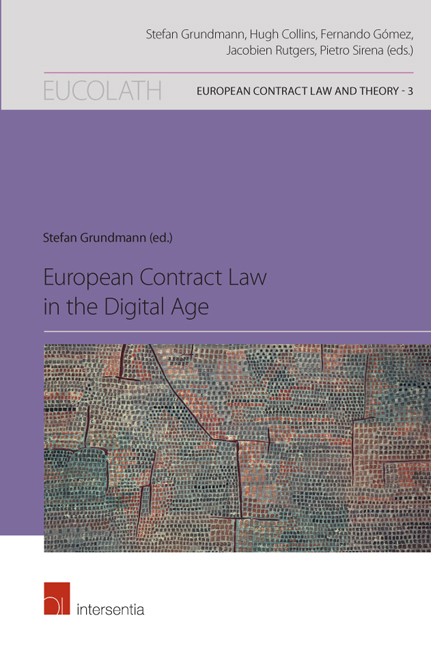Book contents
- Frontmatter
- Contents
- Table of Cases
- List of Authors
- PART I The Overall Architecture
- Part II Institutional Framework – Platforms, Regulation Issues, Global Surroundings
- Part III Digital Formation of Contract – More Virtual and More Formalised
- The E-Commerce Directive, Consumer Transactions, and the Digital Single Market – Questions of Regulatory Fitness, Regulatory Disconnection and Rule Redirection
- Connected Contracts Reloaded – Smart Contracts as Contractual Networks
- The Silk Road Revisited – Money Transactions Inside the Bitcoin System
- Part IV Development and Implementation of Contract – More Digital, More Liquid
- Part V Digital Objects of Contract – CESL II and More
- Index
- European Contract Law and Theory Series
Connected Contracts Reloaded – Smart Contracts as Contractual Networks
from Part III - Digital Formation of Contract – More Virtual and More Formalised
Published online by Cambridge University Press: 11 October 2018
- Frontmatter
- Contents
- Table of Cases
- List of Authors
- PART I The Overall Architecture
- Part II Institutional Framework – Platforms, Regulation Issues, Global Surroundings
- Part III Digital Formation of Contract – More Virtual and More Formalised
- The E-Commerce Directive, Consumer Transactions, and the Digital Single Market – Questions of Regulatory Fitness, Regulatory Disconnection and Rule Redirection
- Connected Contracts Reloaded – Smart Contracts as Contractual Networks
- The Silk Road Revisited – Money Transactions Inside the Bitcoin System
- Part IV Development and Implementation of Contract – More Digital, More Liquid
- Part V Digital Objects of Contract – CESL II and More
- Index
- European Contract Law and Theory Series
Summary
ABSTRACT
Blockchain technology and ‘smart contracts’ are widely debated in many industries, but especially among legal professionals and academics. Some practical legal questions can be answered relatively quickly or have to be postponed by ‘we do not know’ or ‘it depends’.
More interesting than those considerations, however, is whether the emergence of smart contracts based on blockchain technology as a technological materialisation of connected contracts raises issues for the conceptualisation of transnational contract law and what a new conceptualisation, taking into account these issues, could look like.
To this end, this contribution tries to acknowledge or incorporate existing work in the area of technology and law such as ontologies, legal reasoning and simple markup languages, but then goes beyond that and tries to explore a sociolegal concept of smart contracts that incorporates the sociological concept of networks by Latour and the system-theoretical approaches of Luhmann with the descriptions of ‘connected contracts’ by Teubner, ultimately incorporating them into the aforementioned ‘ technological materialisation’ of the network structure of law generally and connected contracts specifically.
This then can serve as an important methodological tool for the future, to research and describe ‘smart contracts’ at a higher level of abstraction.
INTRODUCTION
Certain contractual agents, also called ‘smart contracts’, running on blockchain technology have gained increasing importance due to promising increased automation and assurance for digital contracting, aiming to bridge law and soft ware code. Thus, this contribution investigates these phenomena, recognising that these developments are potentially game-changing for commerce and further digitalisation of contract law.
To this end, ‘smart contracts’ and the systems they are running on are analysed with regard to developments of ‘connected contracts’ and a network(ed) understanding of contract law already developed for newer contractual and company law constructs such as just-in-time production. In order not to limit the examination to ‘traditional’ manufacturing networks but to re-investigate the phenomenon of networks in law more generally, this is complemented by taking account of socio-legal descriptions of networks and law, as well as providing a brief account of current or past alternative approaches to bridge law and technology that are relevant for context and understanding.
- Type
- Chapter
- Information
- European Contract Law in the Digital Age , pp. 205 - 236Publisher: IntersentiaPrint publication year: 2018
- 3
- Cited by

